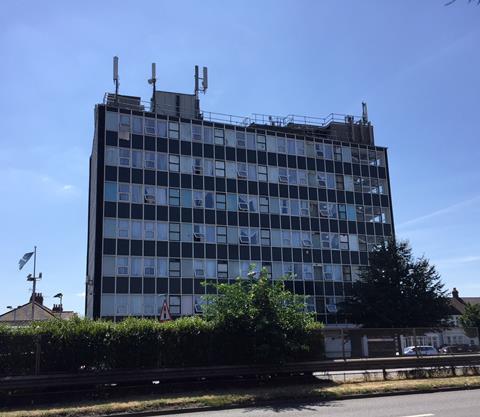Julia Park meets a young woman whose childhood in temporary accommodation has left her determined to end permitted development

At about the same time as I stumbled across Newbury House in Redbridge, a young local woman noticed it too. Immie was passing on the top deck of a bus. Aware that the building was an office, she was unsettled by the flimsy white curtains that were drawn across most of its 200 or so windows. Unsettled because, as she later explained, it took her back to her childhood.
I knew nothing about this until Miles Warde, a Radio 4 broadcaster, got in touch about a programme based around Immie’s background. We met at the end of last year, and she told her poignant story, “My name is Immie” on Radio 4 last week.
Now 22, Immie was very young when her parents separated. When their landlady sold the house that she had shared with her mum and three older sisters, they were priced out of the area and placed in temporary accommodation. Immie was quick to say that despite having the same “standard-issue” tell-tale white curtains that had caught her eye from the bus, their accommodation was quite nice.

Having seen Newbury House, she now feels lucky, but she still described feeling different from her young classmates at school. She mentioned feeling insecure; constantly aware that they might have to leave. In fact, the family spent 10 years in their “temporary” home – proof, if anyone needs it, that temporary means very little. Immie was 12 when the family was finally offered a permanent home. She talked about a huge weight being lifted from her mum who could afford the social rent, and of the new-found sense of security that is every child’s right.
Newbury House had obviously touched a nerve. Hard on the edge of the A12, one of London’s busiest and most polluted roads, it was obvious to Immie that, even from the outside, this was far worse than anywhere she had ever lived. She wanted to find out why anyone has to live in a run-down office block, and to see what it was like inside. During the programme she and Miles describe how they tried to gain access to Newbury House but were told to leave immediately – just as a Guardian reporter had been in 2018. They still don’t know whether they were paid security guards or protective residents but, as Immie says in the programme, “it makes you wonder what they have to hide”.

When we meet I show her the internal floor plans from the planning portal which show 10 “studio flats” per floor, 60 in total. I explain that each door along the corridor is the front door to someone’s home and that each home has just one room with a small shower and toilet cubicle in one corner and a sink and hob in another. We try to imagine living in the smallest one – a room of just 13sq m. Where we could sit, where we could eat, how we could cook, where we might put our stuff and what we would – and wouldn’t – be able to do in this life-limiting space.
She asks why it’s like this. How can the flats be so much smaller than the government says a home for even one person should be? I explain permitted development rights (PDR) and what they mean in practical terms.
It’s a question I’ve been asked many times over the last 18 months. Every time I explain that the government has decided new homes created from existing office buildings shouldn’t be subject to any of the normal planning restrictions – and that means the developers can make them as small as they like – it feels more ridiculous.
We talk about the fact there is often nowhere for children to play, we look at other examples without windows, and we discuss the obvious risk to health, particularly mental health. She asks why it’s still happening and I tell her that I can only conclude that the government finds the numbers too tempting. And that it is filling the gap created by growing need and diminishing social housing.
>> Also read Julia Park on: A new low in office-to-residential conversions
>> Also read: Another council clamps down on permitted development
Since discovering that Newbury House is now home to 60 or more people, this likable and impressive young woman has sent 80 Freedom of Information Act requests to local authorities asking how many people are being temporarily housed in former office blocks. The relatively few replies she received tells its own depressing story.
Immie’s interest in temporary accommodation is partly personal. She knows that while “temporary” can turn into years, it never feels normal, and yet the fear of being told to leave at short notice is even more unsettling. She’s troubled by how much worse the housing situation has become since she was young, particularly for single-parent families and low-income households.
The appointment of Jack Airey as Boris’ new chief housing advisor is deeply worrying
When we met, I was quietly confident about the prospect of policy reform, if not reversal. The independent review of office-to-resi PDR conversions, commissioned by the then secretary of state James Brokenshire in March last year, has been passed to his successor, Robert Jenrick, who also acknowledged quality concerns. He hinted that permission in principle (PiP), the route being proposed for upward extensions, “might be the way to go for other forms of PDR too”. PiP still feels like an unnecessary complication but as the second stage – technical details consent – seems to amount to the equivalent of full planning I, and more importantly those who need a home, could easily live with it.
The report of the independent review is rumoured to be complete, but things have already moved on. The news that Jack Airey of Policy Exchange, described as a centre-right think tank, has been appointed as Boris’ new chief housing advisor is deeply worrying.
Co-written by Airey, Policy Exchange’s latest report, Rethinking the Planning System for the 21st Century, is even more radical than it sounds. It advocates defining just two types of land use – land that can be used for development and land that can’t. On land that can be developed, councils would have no say about either the type, or the use, of development – leave that entirely to the market, says Airey. Similarly, local planning authorities would only be able to define what isn’t acceptable, not what is.
We are told that, left to their own devices, private developers would deluge us with beautiful, sustainable housing in such huge quantities that we’d all be able to afford it.
It’s thought-provoking but wholly misguided. Adding insult to injury, Policy Exchange was founded by Nick Boles, the ex-housing minister who came up with the idea of office-to-resi PDR in the first place. Immie has her work cut out.
Postscript
Julia Park is head of housing research at Levitt Bernstein
















4 Readers' comments